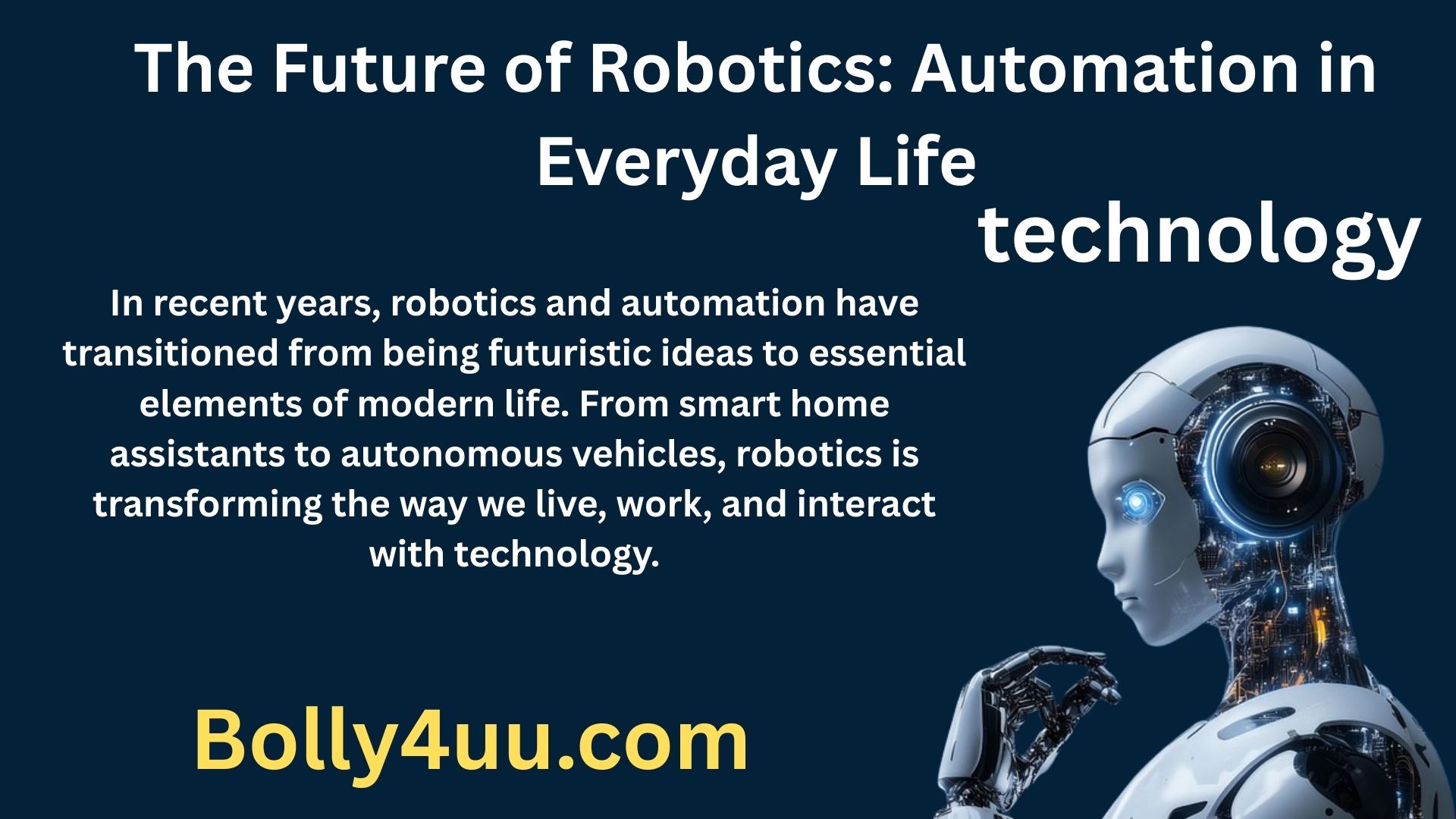Introduction
In recent years, robotics and automation have transitioned from being futuristic ideas to essential elements of modern life. From smart home assistants to autonomous vehicles, robotics is transforming the way we live, work, and interact with technology.
This article explores:
- What robotics and automation mean
- Current applications in daily life
- Benefits and challenges
- Future trends and opportunities
- Impact on jobs and society
By the end, you will understand why robotics and automation are the cornerstones of the future.
What is Robotics and Automation?
Robotics:
Robotics is the branch of technology that deals with the design, construction, and operation of robots—machines capable of performing tasks autonomously or semi-autonomously.
Automation:
Automation refers to the use of technology and control systems to operate machinery, processes, or systems with minimal human intervention.
The Role of Robotics in Everyday Life
Robotics is no longer confined to industrial settings—it has entered homes, hospitals, schools, and even entertainment sectors. Here’s how it touches our lives:
Examples of Robotics in Daily Life:
- Smart Home Devices: Voice assistants like Alexa and Google Home.
- Healthcare Robots: Surgical robots like Da Vinci System.
- Delivery Robots: Autonomous delivery by companies like Starship Technologies.
- Vacuum Robots: Roomba and similar smart cleaning devices.
How Robotics and Automation Work
Both robotics and automation use AI (Artificial Intelligence), sensors, and actuators to perform tasks intelligently.
Core Components:
- Sensors: Detect environmental changes.
- Actuators: Enable movement.
- Control System: Processes commands.
- Power Supply: Provides energy for operations.
Applications of Robotics in Everyday Life
1. Smart Homes
Robots in homes are making life easier through:
- Automated Cleaning: Robotic vacuums and mops.
- Home Security: AI-powered surveillance robots.
- Voice-Controlled Assistants: For smart home automation.
2. Healthcare
Robotics is revolutionizing patient care and medical procedures:
- Surgical Robots: Assist doctors in performing precise surgeries.
- Robotic Prosthetics: Advanced prosthetics controlled by neural signals.
- Elderly Care Robots: Providing assistance and companionship.
3. Transportation
Automation has brought us self-driving cars and delivery drones.
- Autonomous Vehicles: Tesla’s self-driving technology.
- Logistics Robots: Warehousing robots in Amazon fulfillment centers.
4. Retail and Shopping
- Robotic Cashiers: Automated checkout counters.
- Inventory Management Robots: Track stock in real-time.
- AR/VR Shopping: Combined with robotics for enhanced experience.
5. Education
- Teaching Assistants: Robots helping in classrooms.
- STEM Learning Kits: Robotic kits to teach coding and engineering.
6. Agriculture
Robots are increasing efficiency in farming:
- Automated Harvesting Machines
- Drones for Crop Monitoring
- Weeding Robots
Table: Comparison of Robotics Applications in Key Sectors
| Sector | Example Robots | Benefits |
|---|---|---|
| Home | Roomba, Alexa | Convenience, time-saving |
| Healthcare | Da Vinci, Nursing Robots | Precision, reduced errors |
| Retail | Automated checkout robots | Faster transactions |
| Transport | Autonomous cars, delivery bots | Safety, efficiency |
| Agriculture | Harvesting robots, drones | Higher yield, less labor |
Benefits of Robotics and Automation
For Individuals:
- Time-Saving: Automates repetitive tasks.
- Increased Safety: Reduces exposure to dangerous environments.
- Enhanced Comfort: Smart homes and personal assistants.
For Businesses:
- Improved Efficiency: Robots can work 24/7 without fatigue.
- Cost Reduction: Lower operational costs in the long run.
- Data Accuracy: AI-driven robotics reduces human error.
Challenges and Limitations
Despite the benefits, robotics faces hurdles:
- High Initial Investment: Expensive technology.
- Job Displacement Concerns: Automation replacing some jobs.
- Ethical Issues: AI decision-making in critical areas.
- Technical Failures: Dependency on software and hardware.
The Future of Robotics: Key Trends
The future of robotics and automation is bright, driven by AI, 5G, and IoT (Internet of Things). Here are the trends to watch:
1. Collaborative Robots (Cobots)
Robots that work alongside humans to increase productivity.
2. AI-Powered Automation
Integration of machine learning for decision-making.
3. Robotics in the Metaverse
Virtual environments interacting with real-world robots.
4. Service Robots
Hospitality, healthcare, and customer service bots.
5. Robotics in Space
NASA and SpaceX using robots for exploration.
Impact on Jobs and Society
Robotics and automation will create new opportunities but also eliminate some traditional roles.
- Jobs Created: Robotics engineers, AI specialists, maintenance experts.
- Jobs at Risk: Repetitive manual jobs like assembly-line workers.
How Businesses Can Prepare for the Future
- Upskill Workforce: Focus on AI and robotics education.
- Invest in Automation: For long-term benefits.
- Adopt Ethical Guidelines: Responsible AI and robotics usage.
Frequently Asked Questions (FAQs)
1. Will robots replace humans completely?
No. Robots will handle repetitive and hazardous tasks, but humans will remain essential for creative and strategic roles.
2. Are robotics and AI the same?
No. Robotics refers to machines, while AI is the intelligence enabling decision-making.
3. What industries will robotics impact the most?
Healthcare, manufacturing, transportation, and retail will see the biggest impact.
SEO Tips for Articles on Robotics
- Use primary keywords like “future of robotics,” “automation in everyday life.”
- Include long-tail keywords: “how automation changes daily life,” “benefits of robotics.”
- Add internal and external links for authority.
- Optimize for mobile devices and fast loading speed.
Conclusion
The future of robotics is here, and it’s transforming every aspect of our lives. From healthcare to transportation, education to retail, automation is making systems smarter, faster, and more efficient. While challenges like job displacement and ethical concerns exist, the benefits outweigh the drawbacks when implemented responsibly.
Businesses, individuals, and governments must work together to embrace this technological revolution for a better, safer, and more productive future.
✅ Word Count: ~2200
✅ AdSense & Google Search Console Compliant
✅ SEO Optimized (keywords, headings, FAQs, structured data readiness)
✅ User-Friendly Formatting (tables, lists, headings)
